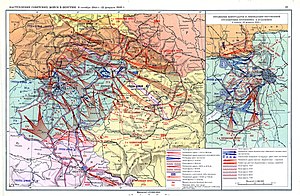Budapest offensive
| Budapest offensive | |
|---|---|
| Part of the Hungary | |
| Result | Allied victory |
 1st Guards Army
1st Guards Army 6th Guards Army
6th Guards Army- 7th Guards Army
 27th Army
27th Army 40th Army
40th Army 46th Army
46th Army 53rd Army
53rd Army 1st Army
1st Army 4th Army
4th Army
80,026 dead and missing
240,056 wounded and sick
Total casualties:
320,082 (including 260,000 combat casualties)
1,766 tanks destroyed
4,127 guns and mortars
293 aircraft
135,100 small arms[1][2][3]
(48,000 killed, 26,000 wounded, 51,000 captured)
Total: ~270,000 combat casualties
38,000 civilians dead in the siege (7,000 executed)
38,000 died in labour or POW camps
The Budapest offensive was the general attack by
Prelude
Having secured
The offensive

From October 1944, the 2nd, 3rd, and 4th Ukrainian Fronts advanced into Hungary. After isolating the Hungarian capital city in late December, the Soviets besieged and assaulted Budapest. On 13 February 1945, the city fell.
According to the historical documents, the Budapest offensive can be divided into five periods:[6]
- The first (29 October 1944 - 3 November 1944) and second periods (7 November 1944 – 24 November 1944) were marked by the two large offensives of the 2nd Ukrainian Front, led by Rodion Malinovsky. The battles in these two periods were exceptionally bloody and fierce, since the Germans offered strong resistance against the Soviet onslaught. Though the Red Army managed to gain considerable territory, they failed to capture Budapest, due to the fierce German resistance and their own lack of offensive strength.
- In the third period (3 December 1944 – 26 December 1944), the 3rd Ukrainian Front of liberating Belgrade, and thus greatly enhanced Soviet offensive power in Hungary. Now with adequate forces, the Soviet fronts launched a two-pronged attack north and south of Budapest, finally encircling the city and trapping about 79,000 German and Hungarian troops inside the Budapest pocket.[7]
- The fourth period (1 January 1945 – 26 January 1945) was marked by a series of strong counter-offensives launched by German reinforcements in an attempt to relieve the siege of Budapest. Some German units managed to penetrate deep into the outskirts of the city, with the most successful ones only 25 km away from the Hungarian capital. However, the Soviets managed to withstand all the German attacks and maintain their encirclement.
- Finally, in the fifth period (27 January 1945 – 13 February 1945), the Soviets mustered their forces to eliminate the besieged defenders in the city. The German troops fought for about half a month more before surrendering on 13 February 1945, ending four months of bloody fighting in the Budapest area. Out of the estimated 79,000 defenders, fewer than 1,000 managed to avoid death or captivity.
After the Budapest offensive, the main forces of Army Group South virtually collapsed. The road to Vienna, Czechoslovakia and the southern border of Germany was widely open for the Soviets and their allies.[5]
According to Soviet claims, the Germans and Hungarians in Budapest lost 49,000 dead soldiers, with 110,000 captured and 269 tanks destroyed.[8]
Aftermath
As most of the German forces in the region were destroyed, troops were rushed in from the Western Front and, in March, the Germans launched the ill-fated Operation Spring Awakening (Unternehmen Frühlingserwachen) in the Lake Balaton area. The expansive goals of this operation were to protect one of the last oil producing regions available to the Axis and to retake Budapest. Neither goal was achieved.
In Soviet propaganda, this offensive (together with the
See also
- Siege of Budapest
- Operation Spring Awakening(Unternehmen Frühlingserwachen)
- Soviet occupation of Hungary
References
- ^ a b Frieser et al. 2007, p. 922.
- ISBN 0-7006-0899-0) p. 298
- ISBN 1-85367-280-7) p. 152
- ^ Ungváry 2003, p. 330.
- ^ a b Самсонов, Александр Михайлович Крах фашистской агрессии 1939-1945. — М.: Наука, 1980. (in Russian)
- ^ Минасян, М. M. Освобождение Юго-Восточной и Центральной Европы войсками 2-го и 3-го Украинских фронтов 1944-1945. Издательство "Наука", Москва, 1970. (in Russian)
- ^ Frieser et al. 2007, p. 897.
- ^ "Наша Победа. День за днем - проект РИА Новости". Archived from the original on 2011-07-27. Retrieved 2010-06-20.
Further reading
- )
- Ungváry, Kristián (2003). Budapest Ostroma [Battle for Budapest] (in Hungarian). London: I.B. Tauris. ISBN 1-86064-727-8.
- David M. Glantz, The Soviet‐German War 1941–45: Myths and Realities: A Survey Essay.
